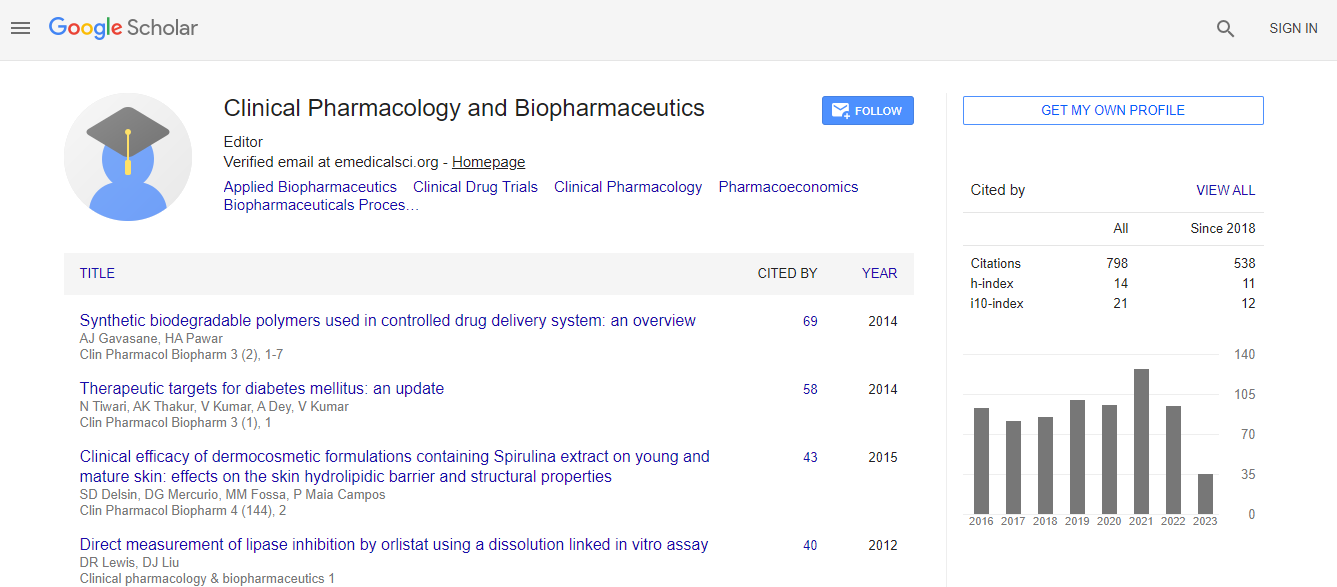Our Group organises 3000+ Global Conferenceseries Events every year across USA, Europe & Asia with support from 1000 more scientific Societies and Publishes 700+ Open Access Journals which contains over 50000 eminent personalities, reputed scientists as editorial board members.
Open Access Journals gaining more Readers and Citations
700 Journals and 15,000,000 Readers Each Journal is getting 25,000+ Readers
Google Scholar citation report
Citations : 1089
Clinical Pharmacology & Biopharmaceutics received 1089 citations as per Google Scholar report
Clinical Pharmacology & Biopharmaceutics peer review process verified at publons
Indexed In
- CAS Source Index (CASSI)
- Index Copernicus
- Google Scholar
- Sherpa Romeo
- Genamics JournalSeek
- RefSeek
- Hamdard University
- EBSCO A-Z
- OCLC- WorldCat
- Publons
- Euro Pub
- ICMJE
Useful Links
Recommended Journals
Related Subjects
Share This Page
Prescribing pattern of PPI and clopidogrel in community pharmacies in Turkey
3rd International Conference on Clinical Pharmacy
E Karatas Kocberber1, N Abunahlah2 and B Berk1
1Istanbul Medipol University, Turkey 2Istanbul Kemerburgaz University, Turkey
Posters-Accepted Abstracts: Clin Pharmacol Biopharm
Abstract
Background & Objectives: Proton Pump Inhibitors (PPIs) are among the most prescribed medications in Turkey. The use of proton pump inhibitors is one of the risk factors associated with treatment failure or unresponsiveness for clopidogrel therapy. Our objective is to describe the prescribing patterns of proton pump inhibitors among the cardiovascular patient in Turkish population. Methodology & Setting: A retrospective study was conducted in 100 patients√ʬ?¬? prescriptions that contain clopidogrel were collected in a period of 3 months from three community pharmacies. Demographic variables were collected from the pharmacy online system and indications for both proton pump inhibitor and clopidrogel were identified. Patterns of drug prescriptions were evaluated and the change in prescription with time was also taken into account. Main outcome measures: The use of PPI like lansoprazol, esomeprazol, pantoprazole, omeprazole, rabeprazole, and clopidogrel were evaluated by using pharmacy medication record system within 6 months period. Prescriptions that include PPI and clopidogrel simultaneously were highlighted. Drug-drug interaction was checked using Medscape drug interaction checker. Results: In the current study, findings showed that, 74% of patients receiving clopidogrel and PPI simultaneously where 26% of patients had received clopidogrel with PPI in the same prescription. The prescription patterns of PPI were found as 25%, 13%, 28%, and 8% for lansoprazole, esomeprazole, pantoprazole and rabeprazole, respectively. Significant drug-drug interaction between PPI and clopidogrel was detected in 38% of patients, 31.7% of these patients received both drugs at the same prescription. 22.9% of the patients had different PPI in the medication histories, 16% of these changes were incorrectly and 6.9% were correctly done. Conclusion: Although most of the prescriptions contain pantoprazole or rabeprazole, there are still some prescriptions that contain lansoprazole in combination with clopidogrel, may reduce the effectiveness of clopidogrel in preventing heart attack or stroke. Community pharmacist must be aware of these types of interaction and must play a role in preventing and monitoring them by calling the prescribers if possible. Increasing the community pharmacist√ʬ?¬?s knowledge towards these types of interactions will lead to decrease the negative economic and health impacts of drug interactions.Biography
Email: emine_krts@hotmail.com

 Spanish
Spanish  Chinese
Chinese  Russian
Russian  German
German  French
French  Japanese
Japanese  Portuguese
Portuguese  Hindi
Hindi 
